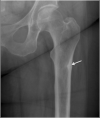Atraumatic fractures of the femur
- PMID: 33684312
- PMCID: PMC8506166
- DOI: 10.1259/bjr.20201457
Atraumatic fractures of the femur
Abstract
Atraumatic fractures of femur, although not as common as traumatic fractures, are frequently encountered in the clinical practice. They present with non-specific symptoms and can be occult on initial imaging making their diagnosis difficult, sometimes resulting in complications. Overlapping terminologies used to describe these fractures may hamper effective communication between the radiologist and the clinician. In this article, we review various atraumatic fractures of femur, terminologies used to describe them, their imaging findings and differential diagnosis. The article also describes the aetiology, pathophysiology and relevant biomechanics behind these fractures. An approach to atraumatic femoral fractures has been outlined.
Figures













Similar articles
-
Osteoid Osteoma of the Femoral Neck in Athletes: Two Case Reports Differentiating From Femoral Neck Stress Injuries.Sports Health. 2016 Mar-Apr;8(2):172-6. doi: 10.1177/1941738115614263. Epub 2015 Oct 28. Sports Health. 2016. PMID: 26517936 Free PMC article.
-
Images in clinical medicine. Osteomalacia.N Engl J Med. 2014 Feb 6;370(6):e10. doi: 10.1056/NEJMicm1308433. N Engl J Med. 2014. PMID: 24499236 No abstract available.
-
Fatigue fracture of the distal femur arising in the elderly.Arch Orthop Trauma Surg. 2005 Jul;125(6):422-5. doi: 10.1007/s00402-005-0804-8. Epub 2005 Jun 14. Arch Orthop Trauma Surg. 2005. PMID: 16034645
-
Imaging Features and Management of Stress, Atypical, and Pathologic Fractures.Radiographics. 2018 Nov-Dec;38(7):2173-2192. doi: 10.1148/rg.2018180073. Radiographics. 2018. PMID: 30422769 Review.
-
Proximal Femoral Fractures: What the Orthopedic Surgeon Wants to Know.Radiographics. 2015 Sep-Oct;35(5):1563-84. doi: 10.1148/rg.2015140301. Epub 2015 Jul 17. Radiographics. 2015. PMID: 26186669 Review.
Cited by
-
Fracture Neck of the Femur: A Case of Two Pathologies.J Med Cases. 2023 Mar;14(3):95-99. doi: 10.14740/jmc4055. Epub 2023 Mar 31. J Med Cases. 2023. PMID: 37032741 Free PMC article.
-
Atypical Presentation of Multiple Myeloma Affecting Appendicular Skeleton Associated with Pathological Neck of Femur and Proximal Humerus Fractures - A Case Report.J Orthop Case Rep. 2024 Aug;14(8):174-178. doi: 10.13107/jocr.2024.v14.i08.4690. J Orthop Case Rep. 2024. PMID: 39157502 Free PMC article.
-
Atraumatic Fractures in Multi-Morbid Older Adults: A Series of Five Cases and Review of Literature.Cureus. 2023 Dec 30;15(12):e51333. doi: 10.7759/cureus.51333. eCollection 2023 Dec. Cureus. 2023. PMID: 38288221 Free PMC article.
References
Publication types
MeSH terms
LinkOut - more resources
Full Text Sources
Other Literature Sources
Medical

